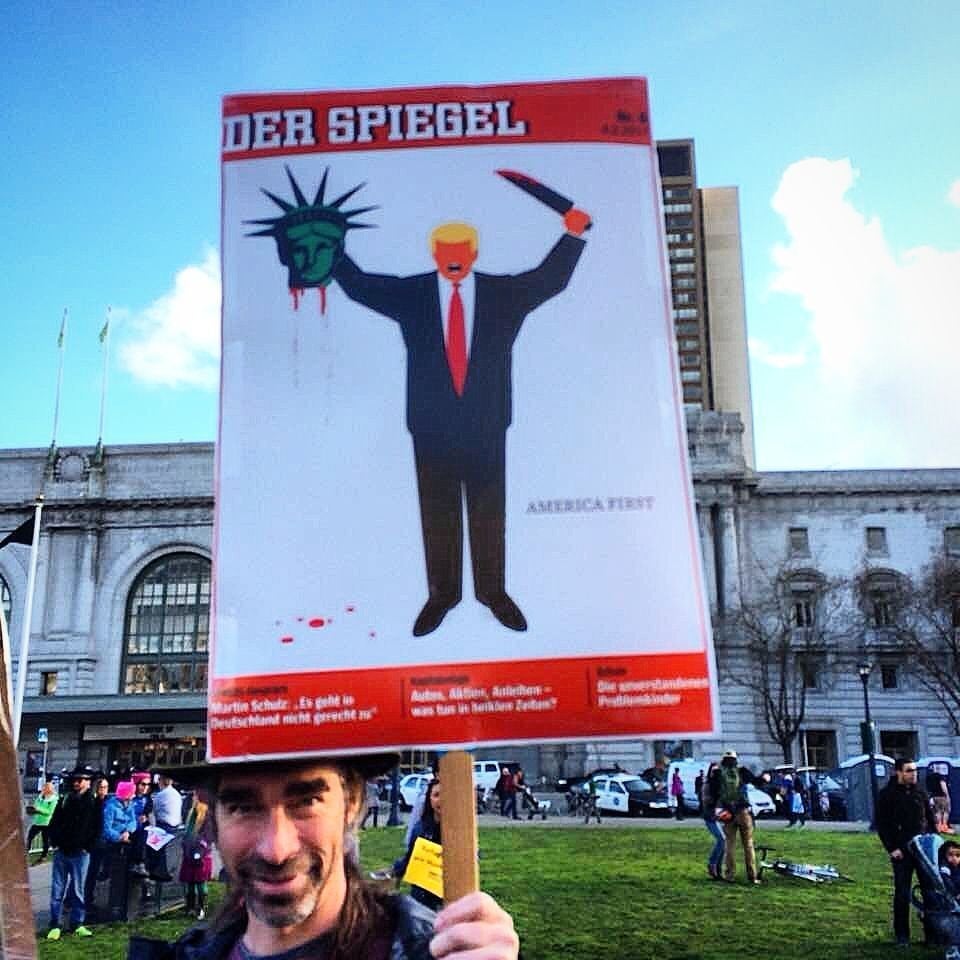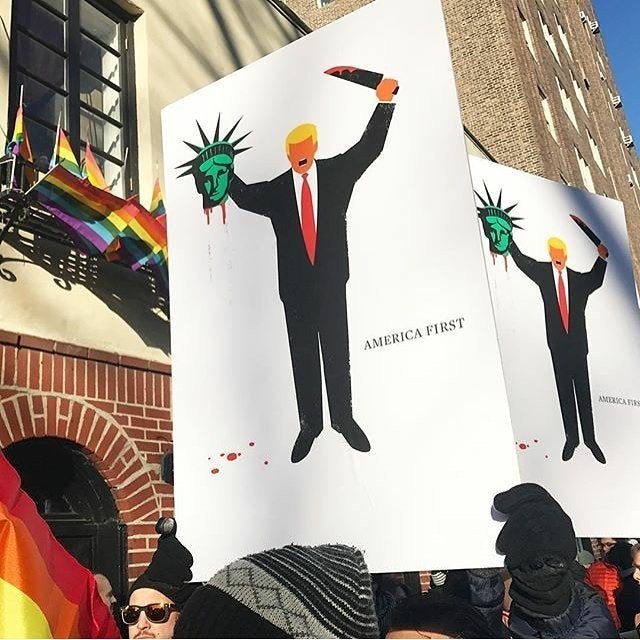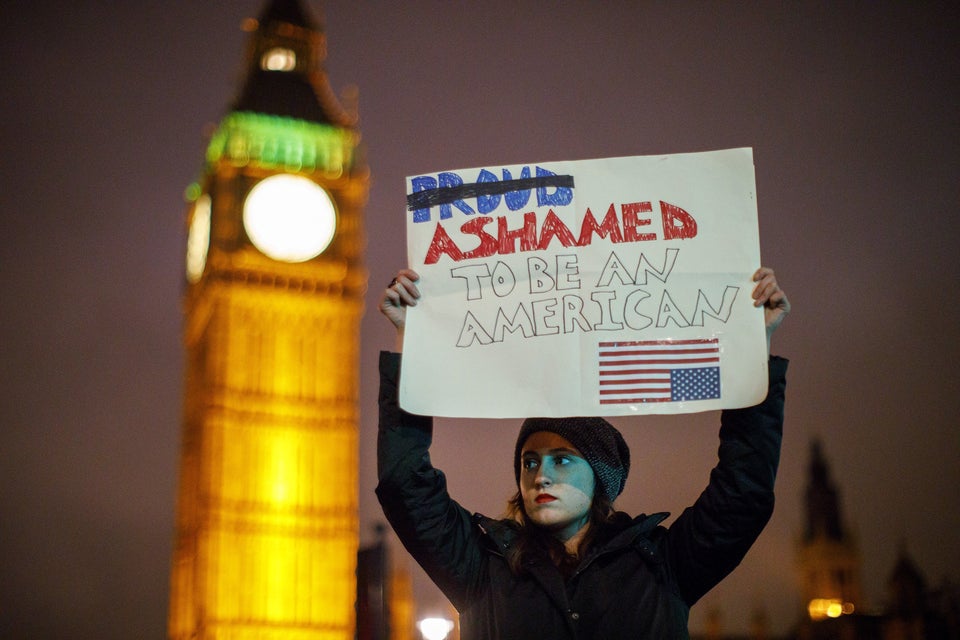”When my family came to New York, the first thing they wanted to do was go to the Statue of Liberty,” artist Edel Rodriguez explained in an interview with The Huffington Post.
Born in Cuba, Rodriguez immigrated to the United States when he was 9 years old, feeling pressure from Fidel Castro’s autocratic regime. Lady Liberty, he recalled, was there to greet him, a profound symbol of hope and acceptance for many who uprooted their lives and resettled on American soil.
In the wake of President Trump’s executive order prohibiting citizens from seven Muslim-majority countries from entering the United States, Rodriguez conjured a simple and blistering image of that welcoming symbol. In his illustration, Trump wields the Statue of Liberty’s decapitated head in one hand, a bloody knife in the other. The image, which appeared on the cover of Der Spiegel on Feb. 4, not so subtly draws a comparison between the leader of the free world and the terrorist group he hopes to eliminate.
“Clearly, lately, what’s associated with beheadings is ISIS, so there’s a comparison,” he told The Washington Post. “Both sides are extremists, so I’m just making a comparison between them.”
Rodriguez began drawing when he was a kid, sketching in his aunt’s pharmacy where he could find ample paper, pens and supplies. When he came to the United States, drawing became a universal language that served him well. “I didn’t speak English,” he said, “so it was a way of communicating with people. I was the art kid.”
Elements of his Cuban upbringing, Rodriguez believes, are evident in his artistic style, which is reminiscent of the graphic political posters he encountered growing up. But such influences, he said, are difficult to separate from the impact that artists like Picasso and Matisse have had on his style.
Rodriguez started drawing Donald Trump during the primaries, attempting, in his way, to caution others of his dangerous potential. “It was a warning,” he said.
“Having grown up in Cuba, and grown up with a bombastic dictator, I see things in Trump that remind me of Castro. I felt like I was in the position to warn people about falling in love with someone with that sort of charisma. The drawings were not for personal pleasure or a release of any kind of energy. It was a call to say: ‘Hey, pay attention.’”
One such drawing consists of melting orange skin, yellow hair and the sole facial feature: a mouth. “He talks so much, that’s why,” Rodriguez said. “Meltdown” graced the cover of Time in August 2016. Its sequel, “Total Meltdown,” hit stands in October.
The artist believes images have a power that words do not ― the ability to communicate to anyone, regardless of their language, background or level of education. “I want to make images that can reach someone with a Ph.D. and someone who is an immigrant laborer who doesn’t speak English.”
Especially nowadays, Rodriguez expressed, when people seem to read little and pay attention to detail even less, art can speak volumes. “Images can grab people’s attention,” he said. “They can tell a complicated story in a simple way. You have an impact. It may be a small impact, but it is an impact. Hopefully, you make people want to look further into an issue.”
The artist has received a great deal of backlash from Trump supporters since his image went viral “These threats and stuff, this is not what democracy is about,” he said. “I’m okay with a conversation. I’m okay with people telling me they support Trump. But when you start calling people names, it’s not what this country is about at all. That’s what living in Cuba was about.”
Realistically, Rodriguez does not expect to change the opinions of those who voted for Trump simply through showing them his work. Instead, he hopes to give those opposed to Trump’s agenda the tools to resist. “I think the one thing I can do is mobilize people that are already feeling a certain way, but don’t know what to do,” Rodriguez said.
“My work encourages people that are a little afraid. When they see what I do, and all the stuff that comes at me, they might say, ‘Wow, that guy has some guts. Maybe I should get some too.’”
Rodriguez puts all of his work online in the hopes that such people will download them and use them to protest, organize and continue to create. Seeing his work pop up among crowds in the Women’s March, airport protests against the executive order, and the recent LGBTQ protest at Stonewall Inn in New York brings Rodriguez great pride.
“My contribution is that my work gets used by people who don’t know how to say something visually,” he said. “There are people who want to march, they want to say something online, they don’t know what to do because they’ve never made a poster. This gives them something to share. That, to me, is everything.”



